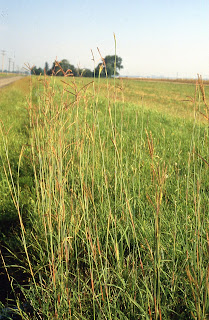People writing about plants are forever sticking the plant family into the discussion.
The photo to the right is a morning glory, Ipomoea (morning glory family, Convolvulaceae)
To the left, yarrow, Achillea millefolium, (sunflower family, Asteraceae)
That intended to be helpful. There are at least 300,000 species of land plants. Nobody knows all 300,000. They are organized into classes made of orders, made of families, made of genera and species. Most of the land plants, about 280,000 species, are flowering plants, angiosperms, and are in the same class. There are approximately 60 orders, 400 families and 12,000 genera of angiosperms. Orders are so big that they contain very diverse plants. For example the order Asparagales includes orchids, onions and century plants. Writers include the plant family in hopes that you’ll know one plant in the family mentioned and it’ll give you a decent guess what the plant described is like.
Here, for example, are capsule descriptions of a few major plant families, not intended to describe their characteristics as much as to prod your memory of them. Plants differ and botanists group them based on those characteristics, so plants in the same family share important characteristics while those in different families seem, and are, different.
Here, for example, are capsule descriptions of a few major plant families, not intended to describe their characteristics as much as to prod your memory of them. Plants differ and botanists group them based on those characteristics, so plants in the same family share important characteristics while those in different families seem, and are, different.
For example, members of the Rose Family have a ring of five petals around a center and produce a usually fleshy fruit with a few hard seeds inside. Lots of them are shrubs or small trees. Members of the rose family, in addition to roses, are apples, plums, apricots and pears.
 |
| Ipomoea sp., Convolvulaceae, morning glory family |
 |
| California oak in flower, Quercus sp., Fagaceae, oak family |
The oak family, Fagaceae, contains mainly tall trees. Most of the familiar north temperate ones are called oaks, genus Quercus. The family also includes chestnuts, Castanea, southern beeches of the Southern Hemisphere, Nothofagus and some tropical species. The flowers are small, wind-pollinated in temperate regions, sometimes insect-pollinated in the tropics. The fruit with the distinctive acorn cap is shared in the whole family.
 |
| grass leaves, Poaceae, grass family |
Sunflowers, daisies, dandelions, yarrow and asters (and some 1,616 other genera, and over 23,500 species) are in the family Asteraceae, characterized by a “flower” that is actually made up of a lot of smaller flowers in a tight cluster. Most of the plants are herbs, though they can grow to 6’ (2 m).
This was is just a glimpse of the diversity of the families, since there more than 400 plant families.
However, it lets me demonstrate the reason for mentioning the family when mentioning the plant.
 |
| asters, sunflower family Asteraceae |
However, it lets me demonstrate the reason for mentioning the family when mentioning the plant.
 |
| service berry, Amelancher, rose family, Rosaceae |
In the hierarchical system started by Linnaeus, plant families are named for a genus in that family, with -ceae stuck on the end. The Rose family is named using Rosa, the genus of roses, as Rosaceae. Poaceae, the grasses, for the genus Poa, Poaceae. Kentucky bluegrass is Poa praetensis. The morning glory family is named for Convolvulus, the bindweeds, as Convolvulaceae.
The plant families turn into jaw-breaking words, but the system is coherent. When encountering one, just break it into syllables: Ros ay cee ee, Po ay cee ee, Con vol vu lay cee ee (in my accent).
These family names are capitalized but not italicized. I'm not capitalizing English descriptions--rose family, grass family--because as explained below, choosing which plant to mention is descriptive, not assigned.
Describing the Asteraceae as the sunflower family is not at all required. We often do that because sunflowers are big conspicuous plants that many people know. It is totally valid to say the Asteraceae is the pussytoes family, but many fewer people know what pussytoes look like. That’s why you sometimes see dandelion family or daisy family instead of sunflower family.
 |
| field bindweed, Convolvulus arvensis Convolvulaceae, morning glory family |
These family names are capitalized but not italicized. I'm not capitalizing English descriptions--rose family, grass family--because as explained below, choosing which plant to mention is descriptive, not assigned.
sunflowers, Asteraceae,
chamomile family |
chamomile, Asteraceae,
sunflower family |
pussytoes, Antennaria sp.,
Asteraceae, sunflower family |
Conversely, there are families that are obscure enough that naming a member doesn’t help many people. Madder, Rubia tinctoria, lady’s bedstraw (Galium verum) and sweet woodruff (Galium odoratum) are in the same family, Rubiaceae. However, I don’t believe any of those plants are familiar to most people, so citing the family doesn’t help you visualize the plant I’m talking about, whether I call it the madder family, bedstraw family or woodruff family. I'm so glad we live in the era of digital photography!
The number of orders, families, genera and species of plants is under continual revision. See "Stevens, P. F. (2001 onwards). Angiosperm Phylogeny Website. Version 12, July 2012 [and more or less continuously updated since]." http://www.mobot.org/MOBOT/research/APweb/. for a widely-used source.
Comments and corrections welcome!
Kathy Keeler, A Wandering Botanist
More at awanderingbotanist.com
Join me on Facebook









No comments:
Post a Comment